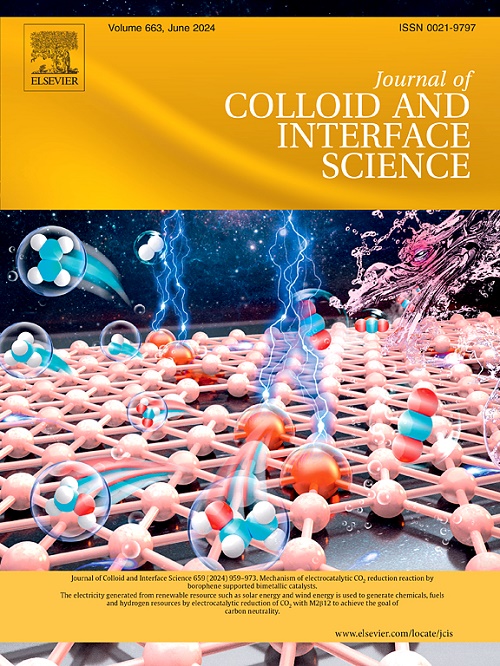调节Cu2X/CNTs空心四面体中Cu的结构,提高H2O2的高效产率。
IF 9.7
1区 化学
Q1 CHEMISTRY, PHYSICAL
引用次数: 0
摘要
电催化剂活性位点的调节是调节氧还原反应(ORR)生成过氧化氢(H2O2)的电子结构和催化选择性的关键。本文合成Cu2X/CNTs (X = Se, SSe, S)空心四面体催化剂,促进O2电催化还原为H2O2。S的引入导致Cu2Se/CNTs上的四电子途径转变为Cu2S/CNTs上的双电子过程,最终导致H2O2产率的提高。重要的是,添加额外的S可以调节活性位点的化学环境,电化学测试表明,Cu2S/CNTs催化剂在h型电解槽的双电子过程中对H2O2具有更高的选择性(超过91%)、产率(360 mmol gcat-1 h-1)和耐久性。原位拉曼光谱结果证实了反应过程中Cu2S/CNTs的结构稳定性,H2O2的积累随着反应时间的延长而增加。各种实验结果和密度泛函数理论(DFT)表明,S原子可以优化活性位点对反应中间体的吸附强度,从而为H2O2生成过程中决定中间体OOH*的形成创造合适的能垒,同时为OOH*的OO键断裂形成H2O保持较高的能垒。该研究为控制H2O2的生成和指导H2O2电合成催化剂的优化提供了思路。本文章由计算机程序翻译,如有差异,请以英文原文为准。

Modulating the structure of Cu in Cu2X/CNTs hollow tetrakaidecahedron to enhance high-efficiency H2O2 production
Regulation of active sites of electrocatalysts is critical in adjusting electronic structure and catalytic selectivity towards oxygen reduction reaction (ORR) to hydrogen peroxide (H2O2). Herein, the Cu2X/CNTs (X = Se, SSe, S) hollow tetrakaidecahedron catalysts were synthesized to facilitate the electrocatalytic reduction of O2 to H2O2. The introduction of S resulted in a shift from four-electron pathway on Cu2Se/CNTs to two-electron process on Cu2S/CNTs, ultimately leading to an enhancement in H2O2 productivity. Importantly, the addition of extra S species can modulate the chemical environment of active sites, and electrochemical tests demonstrate that the Cu2S/CNTs catalyst exhibits an enhanced selectivity (over 91 %), production rate (360 mmol gcat−1 h−1), and durability for H2O2 undergoing a two-electron process by an H-type electrolytic cell. The in-situ Raman spectroscopy result confirms that the structural stability of Cu2S/CNTs during the reaction, and the accumulation of H2O2 increased with the extension of reaction time. Various experimental results and density functional theory (DFT) reveal that the S atoms can optimize the adsorption strength of the active sites to reaction intermediates, thereby creating an appropriate energy barrier for the formation of the determinant intermediate OOH* in H2O2 production, while maintain a high energy barrier for O![]() O bond breaking of OOH* towards H2O formation. This study proves insights into strategies for controlling H2O2 production and guiding the optimization of catalysts for H2O2 electrosynthesis.
O bond breaking of OOH* towards H2O formation. This study proves insights into strategies for controlling H2O2 production and guiding the optimization of catalysts for H2O2 electrosynthesis.
求助全文
通过发布文献求助,成功后即可免费获取论文全文。
去求助
来源期刊
CiteScore
16.10
自引率
7.10%
发文量
2568
审稿时长
2 months
期刊介绍:
The Journal of Colloid and Interface Science publishes original research findings on the fundamental principles of colloid and interface science, as well as innovative applications in various fields. The criteria for publication include impact, quality, novelty, and originality.
Emphasis:
The journal emphasizes fundamental scientific innovation within the following categories:
A.Colloidal Materials and Nanomaterials
B.Soft Colloidal and Self-Assembly Systems
C.Adsorption, Catalysis, and Electrochemistry
D.Interfacial Processes, Capillarity, and Wetting
E.Biomaterials and Nanomedicine
F.Energy Conversion and Storage, and Environmental Technologies

 求助内容:
求助内容: 应助结果提醒方式:
应助结果提醒方式:


